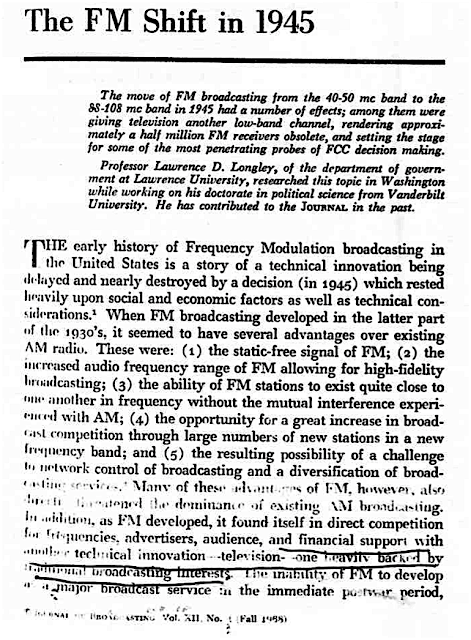Frequent readers of this
blog know that I am a fan of Major Edwin Armstrong, the man who literally
invented frequency modulation (FM) radio despite years of hassle and resistance
from the nation’s biggest broadcasters and equipment manufactures.
After World War II, the
FCC relocated the frequencies for FM stations at the behest of RCA. Though RCA
told the FCC that the change was necessary because of “interference issues,”
RCA wanted the FM spectrum for its soon-to-be-built television service. Plus,
RCA had a decade-old grudge against Armstrong.
Professor Lawrence Longley,
in his article The FM Shift of 1945
(below), summed up the situation this way:
 |
| Major Edwin Armstrong |
Armstrong had stoked the
ire of big corporate broadcasters by introducing FM broadcasting, a superior
system to the status-quo AM system.
In June 1936, Armstrong
debuted FM with a public demonstration at FCC headquarters in Washington, DC.
It went very, very well. Perhaps, too
well.
During Armstrong’s
presentation for the Commission, he used jazz recordings to demonstrate the
differences in fidelity for FM an AM. FM blew AM away.
The FM signal was as clear as a bell. A
reporter who witnessed the demonstration wrote:
"If the audience of 500
engineers had shut their eyes, they would have believed a jazz band was in the
same room. There were no extraneous sounds. Several engineers said after the
demonstration that they considered Dr. Armstrong's invention one of the most
important radio developments since the first earphone crystal sets were
introduced."
RCA and other big broadcasting
interests certainly noticed. Armstrong’s FM system could disrupt the
established order. Not only was the FM fidelity superior to AM, the FM system
was owned by an outsider – an independent college professor from Columbia
University.
 |
| The Mighty W2XMN in Alpine, NJ |
In 1938, Armstrong had
signed on the first FM radio station, W2XMN, at Alpine, New
Jersey, just across the Hudson River from Manhattan.
The Mighty W2XMN was at
42.8 on the then-FM dial. W2XMN’s 40,000-watts covered the entire New York City
market, surpassing many AM stations.
Then the US entered World
War II and FM was “frozen.” As the war
ended 1945, RCA began its push to squash FM at the FCC.
The FCC subsequently moved
the FM spectrum to its current location – 88.1 mHz to 107.9 mHz. This move
made hundreds of thousands FM
receivers obsolete. It ruined Armstrong’s business. RCA tied Armstrong up with
litigation into the 1950s.
Late on the night of
January 31, 1954, Armstrong had had enough. Armstrong opened a window of his
apartment on the thirteenth floor and jumped to his death.
 |
| Lawrence D. Longley |
Enter Lawrence D. Longley,
political science scholar and political activist at Lawrence University,
Appleton, Wisconsin. One of Longley’s
specialties was investigative reporting about government agencies that favored
corporate interests. He wrote about the back-scratching relationship between
RCA and the FCC for the Journal of
Broadcasting in 1988.
The article (below) is called
The FM Shift of 1945. Today it is
considered the definitive work on the topic. It is also a warning about the impact of big money's influence on government decisions.
(click on images to expand them)










No comments:
Post a Comment